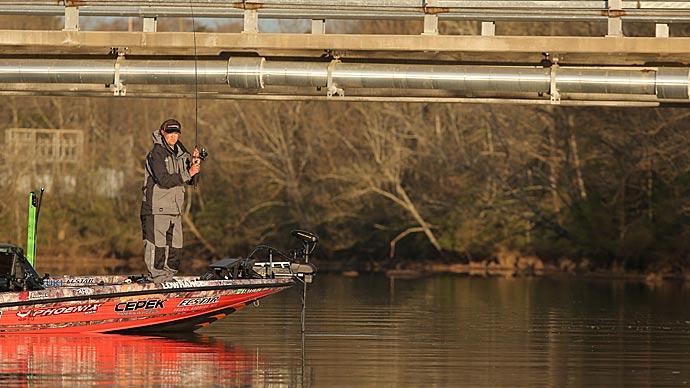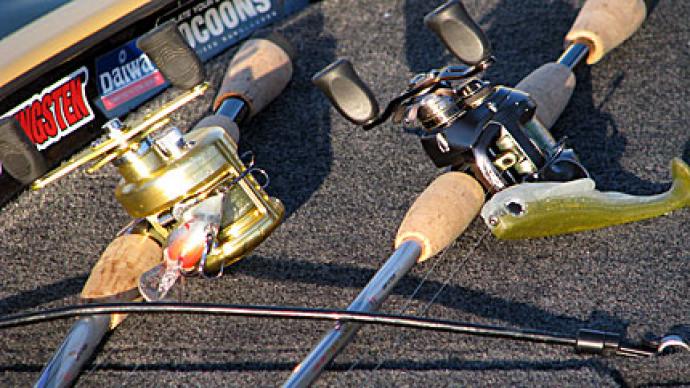| Fields of Southern Grass |
|
In the world of turf and sod, there are "cool-weather grasses" and "warm-weather grasses." Bent grass and fescue, for instance, are earmarked for the North, while Bermuda and centipede grasses flourish down yonder. Joel Richardson, a successful FLW Outdoors basser and Kernersville, N.C., dweller, is intimately familiar with the warm-weather varieties, but those of the aquatic kind. "We call it grass, too," said Richardson, corroborating Bonnema's dissertation of bass on grass. "It fishes the same, but some of the types we fish are different. We have coontail, too, but hydrilla is more common, and it sprouts earlier. Elodea is another grass that bass use quite a bit." Elodea has an appearance and cover quality similar to cabbage. The early spring/prespawn period in Richardson's realm is accompanied by water temperatures in the mid 40s to low 50s, so it's still cool, and things are just getting under way. "I look for grass that's just emerging," Richardson said. "It might be only a couple of inches tall, but that's all it takes." Richardson spies for fresh greens in very explicit places. "I fish main-lake points on the north side of the lake," he said. "It's all about points." He, like Bonnema, begins the crusade of cranks on the outer weedline. In Richardson's case, that means 10- to 14-foot-deep weed edges that are contiguous to a main-lake point. "The first thing I do is graph the point thoroughly, scanning for new growth and pinpointing the outside edge," Richardson said. He does so with a Lowrance LMS-240 because of its ability to mark even stubbly foliage. "What I'm really looking for is the tip of the grass point," Richardson said. Oftentimes, his grassy tip is really a bar or finger projecting from the weed edge rather than a physical, visible point. But regardless, once Richardson finds a grassy haven, he whips out a marker. With a buoy on the surface and fire in his eyes, Richardson commences bombing. The Poe's 300 (12-foot maximum depth) and Bill Norman Deep Diver 14 (14-foot maximum depth) are his essential baits. Like Bonnema, Richardson likes seeing mostly red in the crankbait's coat. He casts and pulls the bait just above grass, touching the canopy on occasion. The retrieve is slow and steady. If and when the lure does slam into the grass, Richardson throttles back and affords the crankbait an opportunity to float free. Sometimes, bushwhacks come when the bait is in repose. The changeover from deep to shallow ensues when water temperatures bounce into the mid 50s to low 60s. While Bonnema probes the body of the flat, questing for upgraded weeds and the occasional hunk of wood, Richardson fires straight for shore. He manipulates the gap between the shore and where the grass starts, concentrating on depths of 5 to 7 feet, and he really likes areas where red clay morphs into gravel. Such transition zones typically yield irregularities in the grass, and bass gravitate toward openings that are encased by lush vegetation. In the warmer shallows, Richardson takes it up a notch, too. He dumps the billed crankbaits in favor of lipless torpedoes like the Rattlin' Rapala, namely the No. 7 Redfire Crawdad. The rate of retrieval is medium to fast on a cord of 12- to 14-pound Stren Super Tough. If big ol' gizzard shad are in the midst, which they often are in the spring, Richardson bumps up to 20-pound mono – for buoyancy's sake – and the portly No. 8 Rattlin' Rapala. Richardson's rod and reel is a precision tool, as is the way he handles snags. "I throw with a 7-foot Shimano V-Rod on a Shimano Calcutta Reel," he said. "The rod is graphite, but it acts like glass, giving a little bit and not ripping. When I do get hung up, I keep reeling and let the rod tip load up until the bait breaks free on its own. That's an important little trick for cranking in the grass." |
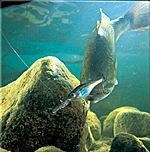
Cold is early spring. Cold is lethargic. Cold is idle. Cold is suspended. Cold is huddled fin-to-fin, tight as a ball. And cold is a small meal for a small appetite.
Few disagree that this is the most trying epoch in the year-long pursuit of largemouth bass. Conditions aren't in our favor. Bass – a species oft touted for their willingness to bite and simplicity to bag – aren't at the top of their game, aren't blowing open the surface, and aren't slurping down plastics like spaghetti. But we pursue them nonetheless. Maybe it's this trial of fortitude that compels us, or possibly the dearth of alternate cold-water targets, such as winter-loving lake trout or arctic grayling.
So we endeavor to overcome spring's obstacles, lending an ear and open mind to innovative and untried techniques as well as tinkering with the known. Crankbaits are in the province of the known but infrequently bandied about in discussions regarding cold-water bass. Instead, full-figured crankbaits hold court in the summer and fall.
Pro Scott Bonnema isn't as biased, though. Oh, sure, he cranks deep weedlines in the hub of summer and bangs bills off rocks in autumn. But equally as meaningful in Bonnema's repertoire is the running of crankbaits through spring's fields of grass.
"There's always grass to be found," said Bonnema, a north-country basser from Zimmerman, Minn., who has considerable experience fishing West Coast and Southern waters, too. "Even in the early spring, some weeds will be present, and the plusher the better."
Before delving further, it's fair to note that what Bonnema constitutes as "grass" is a relative term. The name implies only low-lying, wispy vegetation, but as Bonnema explains, "Grass, as it relates to bass, covers a wide range of vegetation."
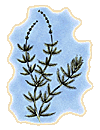
Bushy coontail and fibrous milfoil are grasses and the top dogs on Bonnema's depth chart. Both varieties can survive the winter months. Sometimes mere patches endure, other times none at all. But regardless, coontail and milfoil bud early, which is hugely important.
Cabbage – another bass-fishing staple and substitute grass – seldom survives winter and develops later. The same can be said for eelgrass, which is common in river systems.
So the interval is early spring, and grass is the cover, but where that foliage germinates is as weighty as the fact that it exists at all. "Bass like big weed flats," Bonnema said. "But during the prespawn period, it's not the flat they hold on but the edges of it."
As stated, Bonnema's key flats are roomy, but they also feature a distinct brink, an outer wall. Bonnema says that bass stage or collect on the "edge of the veg" before raiding spawning grounds. Where the weed edge launches into a point with a cuplike inside turn is the best spot of all.
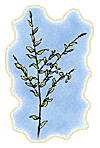
He also smiles on main-lake points that double as weeded flats. "A lot of times you'll find big weeded flats formed over the tops of points," he said. "I look for ones that are 30 to 100 yards across. The best points by far are ones that head into a bay – a recognized spawning bay. I like ones that are 3 to 5 feet deep and dark. Dark water warms faster, and that invites more food, both panfish and baitfish."
As a rule, the warmer the water, the wider the range that bass will exploit. They begin in the early spring on the deep outside weed edge, frequenting depths of 8 to 16 feet. As water temperatures escalate, they assail the shallower flat while clinging to existing weeds, sometimes finning all the way to shore, where they prowl in packs.
"I key on where bass are leaving from and moving to," said Bonnema, who closely surveys the seasonal routes of largemouth bass on natural lakes.
But no matter where bass find themselves within the prototypical migration route, weeds are forever part of the progression. "All it takes is a tiny patch of 5-inch-tall grass to attract fish," Bonnema said. "You won't find the tall stalks like in the summer. They'll either be short, emerging weeds or remnant stuff from last year, but as long as there's some green, it'll hold baitfish and bass."
Bonnema also said that moss and other atypical grasses are often prime spots for finding bass. "Bass will hover over areas of moss, especially if regular weeds aren't available," he said. "Pockets in a big bed of moss always seem to hold fish. Holes or openings become more important in really thick grass. Bass will sit inside sand breaks on a flat that's otherwise covered with coontail or chara." Chara is a stiff and fibrous bottom-dwelling alga that's often referred to as "carpet grass," and it, too, behaves like a bass grass in Bonnema's world.
"In general, grasses create a 'comfort zone' for bass," he said. "They tuck deep inside it, suspend over it and settle in holes that are part of it. Find the weeds, and you'll find the fish – simple as that.
"And I should mention wood. On a weeded flat, if you find submerged timber, you've really got something. Fish love to linger around that timber."
Interestingly, too, Bonnema doesn't pay much attention to water temperature while searching for fish. He operates in an inside-out fashion, starting on deeper staging areas and progressing toward the shallow grass. But once Bonnema happens upon a bass, he quickly appraises the water temperature.
That spot and its features – weeds, depth, etc. – combined with the water temperature create his template. Typically, the road map can be applied to similar locations on the same lake or even other bodies of water.
"Recognizing environmental factors is especially crucial this time of year," Bonnema said. "Spots are very specific, and the bass are usually running pretty tight, too. It's a pinpoint thing."
Intrepid baits in the chilly jungle
The cards were tipped earlier. We won't be talking tubes or discussing drop-shots. Yes, these and other soft and subtle approaches are certainly chic in cold water, and they work, to boot. But Bonnema's a bit more brazen, and he's cranky, too.
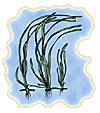
The precise depth of an outside weedline is germane to the lake in question. On Bonnema's northern waters, for example, edges can set up as shallow as 5 to 10 feet of water or as deep as 10 to 20 feet. So Bonnema chooses his weapons accordingly, and his go-to crankbaits hail from the Rapala DT (Dives-To) Series. Designed by crankbait wizard David Fritts, DTs come in two sizes: DT-16 and DT-10. The DT-16, if driven by 10-pound-test mono, dives to 16 feet; and correspondingly, the DT-10 will achieve 10 feet.
Besides laser-like manipulation of depth, the balsa DT also features a robust and lifelike profile that torments even lackluster bass. The average angler might deem it too aggressive a presentation, certainly too hulky for springtime bass. But it's not.
"Bass kill it," said Bonnema, a Rapala disciple and crankbait buff.
Mark Fisher couldn't agree more. Fisher is Rapala-Normark's Director of Field Promotions, a tested tournament angler, close confidante of Bonnema's and believer in the DT.
"The DT Series is what happens when you combine 30 years of David Fritts' crankbait knowledge with the engineering talents of Jarmo Rapala," Fisher said. Jarmo Rapala is the grandson of Lauri Rapala, who is the Rapala in Rapala.
According to Fisher, there are many reasons why the DT shines in Bonnema's situation. First, it dives hurriedly, reaching the targeted zone in haste and consequently staying in the fish zone longer.
Mass is another factor. The DT is laced with extra weight, yielding long casts across spacious pastures.
"Obviously, I throw the DT-10 on shallower breaks and the DT-16 on deep edges," Bonnema said. "Every now and then I go to the Rapala Shad Rap RS to mix things up. Both baits rattle, but only the RS suspends, and sometimes that hovering effect triggers strikes.
"As far as color goes, shad is a good all-around choice, but in the spring, bass really flip over red. Red crawdad DTs are hot, but if there are any smallies in the area, I have to show some chartreuse.
"I don't use any snaps either. I just tie that baby right on – less hardware that way."
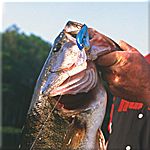
Bonnema waylays a weed edge from the outside. He casts beyond the break, onto the flat, and snaps the crankbait off the tops of the grass. "Snap" pertains to the stroke of the crankbait as it releases from the grasp of a weed, not to Bonnema's cranking speed, which is slow and steady.
Bonnema's apathetic retrieval is realized with a Lew's BB19GS bait-casting reel. The barebones but unswerving reel presents a tedious 4.3-to-1 gear ratio, but that's what Bonnema demands in order to make the crankbait crawl.
With the rod tip pointed toward the water and skewed to 2 o'clock – he's right handed – Bonnema reels just fast enough to interpret a constant vibration from the incoming crankbait. When a fish swings, he sweeps, doesn't jerk, and keeps the reel turning.
"There's no question this is a patient man's game," he said. "First, you've got to be confident that there are fish around, and second, that they'll eat a crankbait in cold water."
Most anglers lack the patience to keep throwing to the same spot like a recurring dream, not to mention trust that a crankbait will get eradicated. Bonnema might make 10 to 15 consecutive throws to the same spot without a single touch, then on the subsequent cast he might get completely whacked, and then he might follow that up with eight bass on eight casts.
"Sometimes it takes that long to motivate the fish," Bonnema said. "But once you do, there might be a whole school of fish ready to strike."
Bonnema doesn't fan-cast either. Bass anglers preach the importance of fully exercising an area, but not Bonnema – not in the spring anyway. "I search out the best bass-holding cover and fish it thoroughly, making repeated casts to the same spot," he said. "It takes patience, great patience, but the tactic pays off."
At some juncture, whether it's a certain day in the week of a month, or a minute in an hour of a day, the bass will depart. "Ready, set, break," they disband from their snug accommodations on the break only to swarm the fruitful flat in loose pods.
Although they could be coerced to feed earlier, out over the break, chow is really starting to sound good about now. Their new environment is warmer, shallower and murkier, with more grass to frolic about.
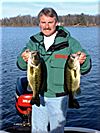
Bonnema's following the motorcade, too. He's jetting up onto the flat and whipping a No. 7 Storm Wiggle Wart around. The chunky 3.75-inch bait is incredible. Bonnema and Fisher swear that its erratic action and wide wobble riles bass, especially those finning in that 5- to 10-foot range. In the spring, Bonnema reaches in the tackle box and snatches either a bone (pearly white) or red-crayfish pattern.
With each cast, Bonnema attempts to make the bait either touch the tops of young grasses or work through it. He still reels slowly but now holds the rod tip waist-high during the retrieve.
Hurling into the throat of the vegetation, he pulls through and shakes the rod tip a spell if the crankbait fouls, maybe giving it a tender snap but not a buggy whip. "Ten-pound mono cuts the weeds pretty quickly," he said. "You don't need to rip it. Plus, that light snap sometimes triggers a hit."
Besides out-and-out greenery, Bonnema also quests for hard spots, especially ones lying beneath patches of grass. "I run my graph, a Lowrance X91, in manual mode," he said. "It shoots right through the grass and gives me an accurate reading of the bottom. And if the bottom goes from soft to hard, I back up and start casting it like crazy. There's something magical about those hard spots."
But as effective as cranking the grass can be, bass occasionally rebuff the notion of tracking a fake fish. So Bonnema, a flexible angler to be sure, changes up voluntarily. Before abandoning crankbaits altogether, though, he does make a few diligent modifications in lure size and color, even changing to nontraditional shapes and models.
Then, as a last-ditch effort, if all cranks are for naught, Bonnema showcases the slow-rolling spinner bait and big, lumbering tube – conventional, accepted springtime baits.
In the final analysis, though, Bonnema's a crankbait guy. He changes attitudes with them, hooks dinosaurs on them, wins tournaments with them, and has enough poise to fish them when the water's got a nip and the "official" crankbait season is still weeks away.



